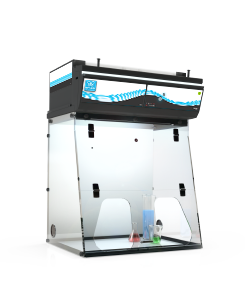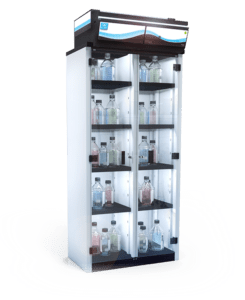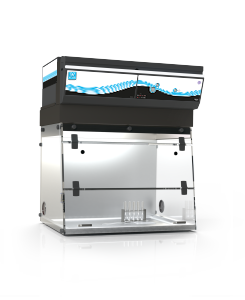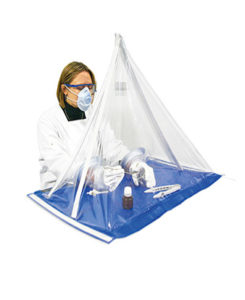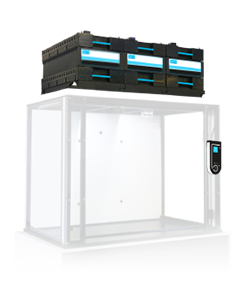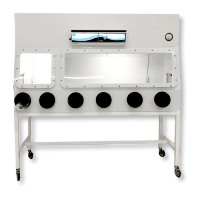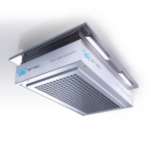Particulate filtration focuses on pollutants that take the form of particles, including dust, allergens, viruses and bacteria, which can be found in aerosols or smoke, for example. This filtration is carried out using high-efficiency filters (HELP/ULPA).
Particulate filters can work in four different ways, depending on the size of the particles to be filtered:
FILTRATION: ERLAB’S CORE BUSINESS
Advanced Molecular Air Filtration Technology
For over a century, activated carbon has been used for its exceptional adsorption properties.
There are many varieties of activated carbon that are currently used in different applications, such as treating water, air emissions and VOCs as well as solvent recovery.
Principle
At Erlab, we have dedicated over 55 years to advancing the science of molecular air filtration, to optimize the efficiency and retention capabilities, while also working to develop ways we can deploy solutions that allow for flexible integration of molecular and particulate filtration. We have achieved these results to improve the diversity of filtered solutions that we are able to provide our customers.
Since 1968, Erlab has been the global leader in filtration technology providing protection for laboratory staff. We put all our efforts into researching, designing, developing and manufacturing durable protection solutions. Air filtration is designed to purify the air through a filter that captures pollutants. There are two types of air filtration: particulate filtration and molecular filtration.
Particulate filtration technology
Interception
The particles are intercepted by the filter’s fibers when they reach them.
Impact
The particles hit the filter fibers and are trapped.
Diffusion
The particles follow their own trajectory and eventually come into contact with the filter fibers.
The electrostatic effect
Using electrostatic forces, the particles passing by the filter’s fibers can be deflected, attracted and then captured by them.
An optimal level of filtration
To guarantee a high level of filtration and thus ensure the device user safety, we use filters of at least HEPA* H14 classification, in line with the MPPS method (most penetrating particle size—see diagram below) as described in the EN 1822 standard. For this particle size, the minimum efficiency of a H14 filter is 99.995%. We also have ULPA* U16 filters, which have a minimum efficiency of 99.99995%.
Molecular filtration technology: Activated carbon
Molecular filtration focuses on pollutants in the form of molecules, including VOCs (volatile organic compounds), gases and vapours. Molecules are retained by adsorption, a phenomenon whereby solids allow certain gases to adhere to their surface.
For over a century, activated carbon has been used for its exceptional adsorption properties.There are many varieties of activated carbon that are currently used in different applications, such as treating water, air emissions and VOCs as well as solvent recovery.
Each application requires a specific type of activated carbon. At Erlab, we have developed a unique range of activated carbons with most allowing for broad range retention capabilities (acid, in-organics, organics, & bases) with some receiving a special blend of pre-filtration for specific chemicals such as Formaldehyde and Ammonia.
Our very strict specifications determine a set of characteristics (particle size, apparent density, hardness, ash content, etc.) that allow us to select the raw materials and formulate them to guarantee the best possible adsorption rates across a wide spectrum of molecules.
These characteristics are rigorously controlled according to protocols described in international standards (ASTM).
However, activated carbon is not the only guarantee of filtration performance. The efficiency of a molecular filter is also dependent on its installation and use.
Thus, the conformity of our fume hoods to the AFNOR NF X 15-211 standard guarantees the performance of molecular filtration.


EXPERTISE
Benefit from 50 years of research expertise in the field of molecular and particulate filtration.
SAFETY
Each batch of activated carbon used in our molecular filters is analyzed in ERLAB’s laboratory in line with current regulations. As such, each molecular filter is delivered with a certificate of conformity.
Our particulate filters are all individually tested according to current regulations and come with a certificate of conformity.
PERFORMANCE
Our filters have a high retention capacity that guarantees maximum filtration performance.
The performance of Erlab’s carbon filters has been validated to guarantee safety and performance by adhering to the AFNOR NFX 15.211 standard and complying with a true chemical listing, assuring that all validations are done with the scientific knowledge of the performance of each filter.
INNOVATION
Benefit from the most advanced molecular filtration technology in the world.
Our R&D team is dedicated to continuously improving our filter performance increasing capabilities and retention capacities.
ENVIRONMENT
Zero emissions, inside and out.
Activated carbon traps pollutants permanently. Coupled with Erlab’s exposure control safety devices, clean air is recirculated back into the laboratory, eliminating chemical emissions from being dumped into the atmosphere as Co2 emission, and reducing the building energy use intensity (EUI).

LATEST TECHNOLOGY
Neutrodine Unisorb:
A testament to our continued innovation providing an expansion to our multipurpose filtration.
The result of Erlab’s latest research, GreenFumeHood 3 is equipped with the new generation of Neutrodine Unisorb filters.
Developed over more than five years by Erlab’s R&D laboratory, this new technology has undergone hundreds of tests, from initial formulation tests on the filtration materials to validating the performance of the new filters in real-life situations.
Neutrodine Unisorb greatly increases the retention capacity of most vapors emitted by laboratory handlings.
These are significant improvements when it comes to the molecules known to be the most difficult to retain with conventional activated carbon filters, such as polar VOCs with low molar masses and low boiling temperatures.
This research has been the subject of two new patents filed by Erlab:
Filter anti-settling system:
US patent number 7,563,301
Neutrodine Unisorb filter:
US patent application number 12/465,434
Improved performance compared to conventional filters.
Advantages of
Neutrodine Unisorb filtration:
Option to handle solvents, acids and bases simultaneously with the same filter.
Unprecedented retention capacity.
Unique formulation with no carbon mix.
No heavy metal impregnators.
The choice of Erlab superactivated carbon.
Scope of application, retention capacity, formulation:
Erlab's choice of overactivated carbon is available in 5 references.

Erlab Carbon
type Neutrodine
Versatile for
vapors and gases
Chemical properties
Appearance: Granules
Odor: None
Color: Black

Erlab Carbon
type AS
For predominantly
organic vapors
Chemical properties
Appearance: Granules
Odor: None
Color: Black

Erlab Carbon
type BE +
For predominantly
acidic and organic vapors
Chemical properties
Appearance: Granules
Odor: None
Color: Black

Erlab carbon
type F
For formaldehyde vapors
Chemical properties
Appearance: Granules
Odor: None
Color: Black

Erlab carbon
type K
For ammonia vapors
Chemical properties
Appearance: Granules
Odor: None
Color: Black



